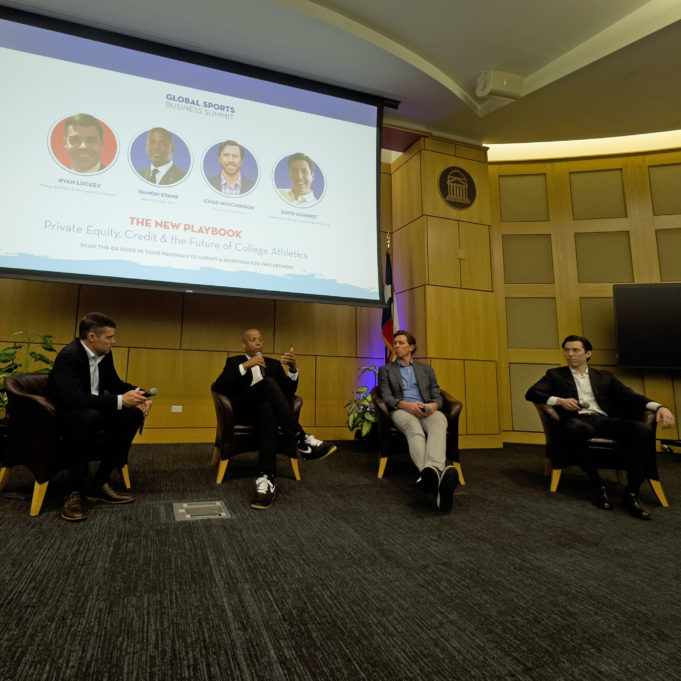One could find a lot to learn about the business of sport at this past week’s Global Sports Business Summit, presented by SMU and the Dallas Sports Commission. One thing we discovered is that college sports is in some turmoil right now.
If you’re a sports fan, you probably already had that development on your radar. Issues like the House case settlement, NIL, the transfer portal, unionization, and more have thrust the disruption of traditional models into prominent media placements for a while now. But a panel entitled “The New Playbook: Private Equity, Credit & the Future of College Athletics” provided some fresh insights and some perspectives to ponder.
We can say “fresh” because one of the participants just began a new job in which he has to deal with these issues. Damon Evans started as SMU’s Director of Athletics a little over a month ago. He’s served in the same position at two Power Four conference schools previously, but he recognizes that not only does he face unprecedented challenges in 2025, he has to welcome adjusting to them in the public eye.
“I always enjoyed the opportunity to get out and speak and meet individuals and share some of the thoughts that I have in this rapidly evolving world of intercollegiate athletics. One that I would say: we always got to embrace change. A lot of people run from change, but we’ve got to embrace it. We’ve got to adapt to it,” he said.
The panel topic had to do with one potential change under discussion: whether private equity investors might get involved with college athletics as they have recently begun to do in professional sports. Two of Evans’s fellow panelists not only work in the investment space, they also played at the intercollegiate and pro levels. They’d like to see the changes resolve themselves, both for the sake of the student-athletes and the potential business opportunities.
“I think there needs to be an institutionalization of what’s going on right now, because I just think it’s absolutely the wild west,” said Chad Hutchinson, a partner at Arctos Sports Partners who played football and baseball at Stanford.
Uncertainty in any industry can discourage business investment when it creates difficulty in predicting returns. That might be especially true in an emerging industry like college athletics that has not previously presented itself as an investment vehicle.
“At Arctos, we’ve built our business around investing in pro sports franchises, but we’ve spent the better part of the last four years looking at college ecosystem, how we invest money into it,” said Hutchinson. “I don’t know if now I have any clarity and vision on if it’s investable from an institutional capital perspective, And we spent a bunch of time with athletic departments, universities. We’ve been in part of every conference-level discussion, trying to recapitalize, trying to own a piece of it. How do we monetize this? And I think it’s very challenging.”
Part of the issue is that the university system business model, in which almost every school with an intercollegiate athletic program is either state-owned or a nonprofit entity, was not designed as a potential investment vehicle.
“We require equity-like returns,” Hutchinson said. “When we invest in teams, there’s an exit. We sell the team, right? So we invested in the Tampa Bay Lightning two-and-a-half years ago. The Tampa Bay Lightning just sold. It’s a great return for our investors. Our investors are pension funds, endowments, university endowments. They want a return to their capital, right? And the way you get that is either through a cash flow distribution or an appreciation of the asset and you sell the asset. Are you going to sell the SMU athletic department? No, right? You’re not going to sell it. So it’s very challenging.”
Evans noted that the University of Kentucky had announced plans to spin off its athletic department into a for-profit limited liability company.
“They’re moving into a model where it’s going to be easy to engage with private equity groups when you’re an LLC, as compared to when you’re a part of the public institution,” said Evans. You could technically sell a stake in that, that you take it out from under the umbrella of the state system, the government, and so forth.”
Hutchinson quickly chimed in.
“You can sell an LLC. I’ll come invest in that.”
If Arctos did decide to jump into such a deal, it would be guessing that the spun-off entity would retain a lot of its positive attributes, including fan loyalty. Panelist David Schmidt of Goldman Sachs suggested that the ongoing changes in college athletics could affect how a firm like his would evaluate such an opportunity.
“When you think about what we’re trying to accomplish as a brand, you want to be a trusted advisor. You want to gain the public’s trust so that they’re willing to work with you, and they feel like you guys are someone that’s advocating for them,” said the former Stanford pitcher. “Along the lines of the students, which are the product, the most important thing, as far as what goes into the day to day and what makes this great in college athletics, I think it hearkens back to everybody’s time in school and just understanding what it was like to be a student and in some instances, a student-athlete. And as we get a little bit further away from that, you start to lose that fabric that ties everybody together.”
Would fans retain existing allegiances if they perceive the “student-athletes” wearing their university’s colors as simply employees of a for-profit corporation?
“I like to stay focused on the student-athlete,” said Evans. Each panelist then offered examples of how conference realignment based in large part on the sport that generates the most revenue already seems to make the traditional student-athlete experience more challenging.
“Stanford is in the Atlantic Coast Conference, but is nowhere near the Atlantic Ocean,” noted moderator Ryan Luckey of Arluck Advisors. “It makes sense that the football team can travel to Chapel Hill or Virginia can fly out for a home game. That model doesn’t work for swimming, for track and field, for fencing, for golf.”
“When I was playing, we went to the Super Regionals down in Tallahassee against Florida State,” Schmidt remembered. “We had to fuel up. I think it was in Nashville, because the plane couldn’t make it all the way. So imagine having to do that every single weekend and playoffs. And then on top of that, you layer in your classes, you layer in your tests, you layer in everything else that you have going on.”
“I just hosted the Stanford tennis team here three weeks ago to dinner, and they stopped in, played against SMU,” said Hutchinson. “This was their third time down to Dallas in the last six weeks. The kids had been in class for four days out of the last month because they were going from here up to Boston College. And mind you, they’re, traveling, like, connect here, connect there. The coach is a friend of mine, and they had a 24-hour travel day, like, full day because of delays and stuff. And so this is unsustainable.”
Evans put the situation in perspective from a financial standpoint.
“If you’re playing soccer, if you’re playing baseball, if you’re running track, if you’re playing tennis and you’re playing golf, those sports are impacted the most with regard to travel. And at the same time, from an NIL or revenue-share perspective, those are the sports that are being paid the least, but actually being impacted the most,” he said. “You could have just realigned football around the country, but what we did, we realigned everything. And now the cost associated with the travel and everything that we need to do with all those other sports is astronomical.”
No investor wants to hear that a venture’s costs are large while revenue is limited. Evans said he thinks a regionalization model for Olympic sports will eventually emerge. But in the meantime, uncertainty reigns. A concept like Kentucky’s Champions Blue, LLC could open the door to private equity investment from a structuring perspective, but without bigger-picture resolution of the issues that could limit returns, a firm might shy away.
One question one should likely ask about such an entity also involves failure. Can a Champions Blue, LLC fail? Or would it be bailed out by the government if it does not do well? Assurance of a public-sector rescue, along with continued use of taxpayer-subsidized educational facilities, government-standard liability limits, and the UK brand could mitigate uncertainty for investors. Such a scenario would also come with a Fannie Mae-sized dose of moral hazard in terms of state taxpayers being on the hook for sub-par business decisions by athletic departments.
Evans pointed out that “at a private (university) you have a little bit more flexibility to do things.” A for-profit spinoff of an athletic department or football team might be easier in the private nonprofit sector, though it might also carry more risk. But an upside-minded investor group might hope to create the “Wrexham of College Football” with an investment of resources and expertise into an ambitious lower-tier school. The structure of what that could look like is as amorphous as the college sports landscape itself.
Gatherings like the summit are supposed to make you think. So is college. One interesting question among all of it is where the “college” part of “college sports” will land.
“I always looked at college athletics as an opportunity to earn an education,” said Evans.
For decades, student-athletes have accepted the lifetime value of a Stanford or SMU degree as a sufficient return in exchange for whatever value they themselves returned to the institution. Former college performers like Evans, Hutchinson, and Schmidt leveraged at least some of what they learned to propel them along their current career paths. Now it’s up people like them to figure out how the ROI equation for all stakeholders will evolve in the future.












